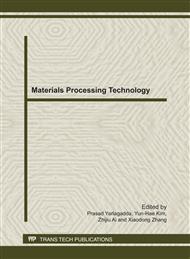p.489
p.494
p.498
p.503
p.507
p.511
p.517
p.522
p.526
Fatigue Crack Growth Rates in Friction Stir Welding Joints of 7075-T6 Al Alloy and Fatigue Life Prediction Based on AFGROW
Abstract:
In this work, a study of fatigue crack propagation (FCP) behavior of friction stir welding (FSW) joints of 7075-T6 aluminum alloy was carried out. Fatigue crack growth rate curves were determined for cracks growing in different locations of the welding lines, including prefabricated crack through welding seam center, advancing side (AS), retreating side (RS), and vertical to welding seam. A computational simulation of fatigue crack propagation was conducted by AFGROW with different stress ratios R, and the effects of R on FCP rate were analyzed. Results showed that the FCP rate in RS of the Heat Affected Zone (HAZ) was the lowest and the highest was in the region vertical to the welding seam. In the low stress intensity factor range (△K) region, the FCP rate in Nugget Zone (NZ) was lower than that in AS of the HAZ, but in the high △K region, the situation was contrary. Reasons of the results were analyzed. Compared with the standard of International Institute of Welding (IIW), FCP rates in all regions were lower and it concluded nice fatigue properties of FSW 7075-T6. The simulation made in terms of crack propagation rate (da/dN) versus △K generally showed a good agreement with the measured values. The study of effects of different R on FCP rates based on AFGROW indicated that FCP rates increased with increasing R.
Info:
Periodical:
Pages:
507-510
Citation:
Online since:
September 2011
Authors:
Price:
Сopyright:
© 2011 Trans Tech Publications Ltd. All Rights Reserved
Share:
Citation:


